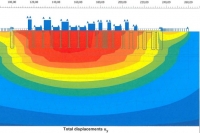IKEA Furniture Mall, Zagreb, Croatia
Client: BAUER Spezialtiefbau GmbH, Vienna
Development Period: since 7/2012
In the capital of Croatia, a large furniture mall of the IKEA corporation is planned.
The building complex extends over a length of 200 m and a width of up to 80 m.
The underground in the project area consists up to great depths of floodplain sediments with intermediate peat layers. The floodplain sediments are built up, down to a depth of 15 m, of soft to firm silt and clay. Below, a gravel layer sets in, which is followed by alternating layers of finely and coarsely grained material.
A deep foundation by means of cast-in-place bored piles was already considered in the tendering phase of the project.
Shortly before the construction, a subsoil situation was discovered, during a deep drilling for geothermic energy, that differed from the previous subsoil model. Subsequently, BGG Consult was consulted by the special heavy construction company in order to clarify the situation from a geotechnical perspective.
For a detailed exploration, four drillings, each with depths of 40 m, eight CPTs (cone penetration tests) and ten pressiometer tests were carried out. Furthermore, soil physical laboratory tests were run on numerous soil samples. Based on the results, expert's statements were worked out.
The substantial task consisted on the one hand in the evaluation of the feasibility of the originally planned foundation method and on the other hand in the estimation of the expected settlements. For the latter, extensive finite element calculations were conducted.
Deep Foundation within a Gravel Layer with a Limited Thickness:
In the course of the detailed investigation, it emerged that the gravel zone, which was intended for the foundation, holds a thickness only between 4 m to 10 m. Below, cohesive material with soft consistency was found. In close coope-
ration with the designers and with reconcilement of external supervisors, the foundation in the intermediate gravel layer could be approved.
The consideration of international standards with regard to methods of approach and documentation posed a special challenge in this project.
June 2013
